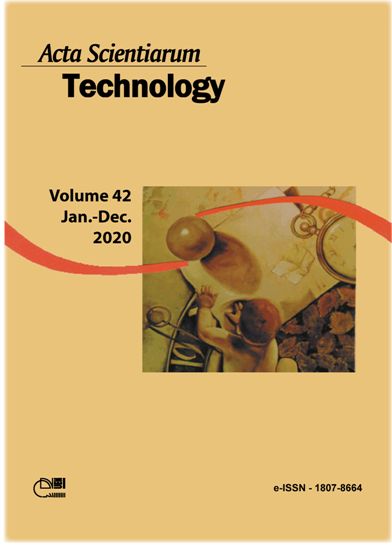Bioactive compounds and in vitro antioxidant activity of pulps from fruits from the Brazilian atlantic forest
DOI:
https://doi.org/10.4025/actascitechnol.v42i1.44503Palavras-chave:
Cambuci; feijoa; uvaia; grumixama; multivariate analysis.Resumo
The fruits belonging to the family Myrtaceae are known sources of compounds with functional characteristics. Nevertheless, the studies are focused only on some species of this family. In this sense, we aimed to quantify the bioactive compounds present in the pulps of cambuci, feijoa, uvaia and grumixama; to evaluate the in vitro antioxidant capacity of each one and to correlate the contribution of these bioactive compounds with the antioxidant activity of each fruit pulp. For this, the compounds ascorbic acid, phenolic compounds, carotenoids, and flavonoids were quantified for the pulps of cambuci, feijoa, uvaia, and grumixama, as well as the in vitro antioxidant capacity by the methods DPPH and ABTS. The results were evaluated by multivariate statistical techniques. The pulps present good antioxidant potential, the one from cambuci presented the highest values for antioxidant activity given by the method DPPH (61.86 µg of Trolox g-1), that from uvaia was prominent by the presence of ascorbic acid (85.40 ascorbic acid 100 g-1) and that from feijoa, by the flavonoid contents (62.45 mg quercetin g-1) and phenolic compounds (10.21 mg gallic acid equivalent g - 1). A correlation was observed between pulp antioxidant capacity and the contents of ascorbic acid and carotenoids; on the other hand, the phenolic compounds and flavonoids little contributed for the anti-free radical activity of the methods DPPH and ABTS.
Downloads
Downloads
Publicado
Como Citar
Edição
Seção
Licença
DECLARAÇíO DE ORIGINALIDADE E DIREITOS AUTORAIS
Declaro que o presente artigo é original, não tendo sido submetido í publicação em qualquer outro periódico nacional ou internacional, quer seja em parte ou em sua totalidade.
Os direitos autorais pertencem exclusivamente aos autores. Os direitos de licenciamento utilizados pelo periódico é a licença Creative Commons Attribution 4.0 (CC BY 4.0): são permitidos o compartilhamento (cópia e distribuição do material em qualqer meio ou formato) e adaptação (remix, transformação e criação de material a partir do conteúdo assim licenciado para quaisquer fins, inclusive comerciais.
Recomenda-se a leitura desse link para maiores informações sobre o tema: fornecimento de créditos e referências de forma correta, entre outros detalhes cruciais para uso adequado do material licenciado.



















